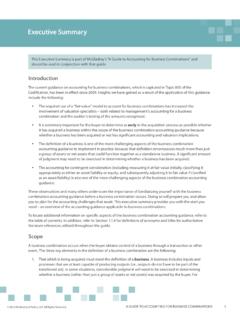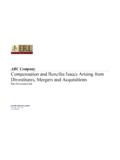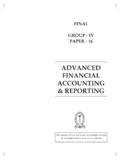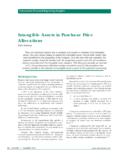Transcription of Preserving NOLs and credit carryovers in an M&A ...
1 mergers and Acquisitions Tax ServicesPast losses, future gainsTax attributes such as net operating losses and built-in losses (assets with a tax basis higher than value) can provide a tax shield against future taxable income. These tax attributes will be referred to as NOLs in this discussion. Whether you are a strategic or financial buyer, protecting and maximizing the value of those NOLs is a key consideration in the economics of any transaction. Even if you don t plan on utilizing NOLs currently, your ability to utilize the tax benefits of an NOL is an important part of financial reporting, and your failure to properly determine the benefit could result in negative financial statement companies not involved with traditional change-in-control transactions may find their NOLs at risk through ownership changes triggered by day-to-day stock trading or fundraising activity. S corporations changing to C corporation status also need to be aware of the impact of an equity issuance or change in Congress enacted Internal Revenue Code section 382 to prevent trafficking in losses.
2 But the rules surrounding section 382 are quite complex, often misunderstood, and driven by the unique facts and circumstance surrounding each particular company and transaction. Complex rules require careful analysisIf you are acquiring a company with NOLs, annual utilization of that company s NOLs is generally limited to the value of the loss corporation multiplied by the adjusted federal long-term tax-exempt rate. But the analysis does not stop there. Having a full understanding of a company s status as a Net Unrealized Built-in Gain (NUBIG) or Net Unrealized Built-in Loss (NUBIL) corporation is critical. The annual utilization of NOLs can be increased significantly if the acquired company is a NUBIG corporation. But, if the company is a NUBIL corporation, even post-ownership change losses may be treated as if they were recognized prior to the ownership change, thereby further limiting the ability to utilize NOLs. Determining the annual utilization is further complicated by bargain sales, distressed transactions and leveraged acquisitions, it is not only the acquiring party that will need to understand the target s NOLs.
3 Sellers wishing to be compensated for the value of the loss corporation s NOLs should also understand and document future availability of NOLs. acquirers leave that assessment and documentation up to the seller. Section 382 Analyses Preserving NOLs and credit carryovers in an M&A transaction or other equity transactionDo you know if any of your tax attributes are subject to limitation?Do you know if your company has undergone an ownership change?Do you understand the complexities of section 382?Acquisitions are not the only concernCompanies thinking that the section 382 rules are only a concern during acquisitions are incorrect. Stock trading, capital raising and even recapitalizations can trigger ownership changes under section 382 and companies with multiple classes of stock face particularly complex all the news is bad, nor is a change in ownership always a negative event. Companies often overlook planning opportunities as well as risks.
4 Companies that are highly leveraged or have significant self-created intangible assets at the date of an ownership change may have built-in gains that can lead to enhanced NOL utilization. As a result, incurring a change in ownership does not necessarily mean that you are unable to fully offset current taxable income or that a reserve must be booked for financial statement purposes. Multiple classes of stockThe application of section 382 is further complicated when the company has multiple classes of stock outstanding. Ownership under section 382 is based upon stock value, and therefore, when there are multiple classes of stock involved, determining value becomes a more complicated exercise than when there is only a single class. Further, a shareholder s ownership may change over time merely due to value fluctuation. This fluctuation may cause ownership shifts unrelated to any stock purchases, sales or other transactions. Because of value fluctuation, taxpayers are permitted to apply one of two methods when performing a section 382 analysis either, the full value methodology or the hold constant principle.
5 Understanding which method to apply can be of great benefit to taxpayers, as one method may yield a more favorable outcome than the 382 is not new to usWhether your company is considering an acquisition or other equity transaction, section 382 concerns may be new to you. They are not new to McGladrey. Our national M&A tax group has helped companies across all industries plan for and address NOL concerns involved in acquisitions and other ownership changes. We are experienced, in deals of all sizes, from strategic trasactions by large publicly held companies to portfolio deals for private equity firms to acquisitions involving privately held start-up companies. Based on our knowledge and experience, we can help you examine the specifics of your situation and work with you to plan for and structure transactions ranging from acquisitions to stock offerings in ways that best fit your strategic goals while still helping to maintain the tax benefits associated with your losses or those of a target This document contains general information, may be based on authorities that are subject to change, and is not a substitute for professional advice or services.
6 This document does not constitute assurance, tax, consulting, business, financial, investment, legal or other professional advice, and you should consult a qualified professional advisor before taking any action based on the information herein. McGladrey LLP, its affiliates and related entities are not responsible for any loss resulting from or relating to reliance on this document by any LLP is an Iowa limited liability partnership and the member firm of RSM International, a global network of independent accounting, tax and consulting firms. The member firms of RSM International collaborate to provide services to global clients, but are separate and distinct legal entities that cannot obligate each other. Each member firm is responsible only for its own acts and omissions, and not those of any other , the McGladrey logo, the McGladrey Classic logo, The power of being understood , Power comes from being understood , and Experience the power of being understood are registered trademarks of McGladrey LLP.
7 2014 McGladrey LLP. All Rights Item # RSM96
















